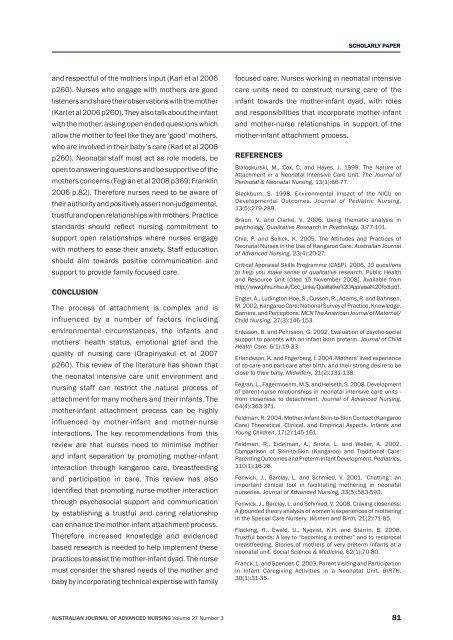March-May, 2010 - Australian Journal of Advanced Nursing
March-May, 2010 - Australian Journal of Advanced Nursing
March-May, 2010 - Australian Journal of Advanced Nursing
You also want an ePaper? Increase the reach of your titles
YUMPU automatically turns print PDFs into web optimized ePapers that Google loves.
Scholarly PAPER<br />
and respectful <strong>of</strong> the mothers input (Karl et al 2006<br />
p260). Nurses who engage with mothers are good<br />
listeners and share their observations with the mother<br />
(Karl et al 2006 p260). They also talk about the infant<br />
with the mother, asking open ended questions which<br />
allow the mother to feel like they are ‘good’ mothers,<br />
who are involved in their baby’s care (Karl et al 2006<br />
p260). Neonatal staff must act as role models, be<br />
open to answering questions and be supportive <strong>of</strong> the<br />
mothers concerns (Fegran et al 2008 p369; Franklin<br />
2006 p.82). Therefore nurses need to be aware <strong>of</strong><br />
their authority and positively assert non‐judgemental,<br />
trustful and open relationships with mothers. Practice<br />
standards should reflect nursing commitment to<br />
support open relationships where nurses engage<br />
with mothers to ease their anxiety. Staff education<br />
should aim towards positive communication and<br />
support to provide family focused care.<br />
CONCLUSION<br />
The process <strong>of</strong> attachment is complex and is<br />
influenced by a number <strong>of</strong> factors including<br />
environmental circumstances, the infants and<br />
mothers’ health status, emotional grief and the<br />
quality <strong>of</strong> nursing care (Orapiriyakul et al 2007<br />
p260). This review <strong>of</strong> the literature has shown that<br />
the neonatal intensive care unit environment and<br />
nursing staff can restrict the natural process <strong>of</strong><br />
attachment for many mothers and their infants. The<br />
mother‐infant attachment process can be highly<br />
influenced by mother‐infant and mother‐nurse<br />
interactions. The key recommendations from this<br />
review are that nurses need to minimise mother<br />
and infant separation by promoting mother‐infant<br />
interaction through kangaroo care, breastfeeding<br />
and participation in care. This review has also<br />
identified that promoting nurse‐mother interaction<br />
through psychosocial support and communication<br />
by establishing a trustful and caring relationship<br />
can enhance the mother‐infant attachment process.<br />
Therefore increased knowledge and evidenced<br />
based research is needed to help implement these<br />
practices to assist the mother‐infant dyad. The nurse<br />
must consider the shared needs <strong>of</strong> the mother and<br />
baby by incorporating technical expertise with family<br />
focused care. Nurses working in neonatal intensive<br />
care units need to construct nursing care <strong>of</strong> the<br />
infant towards the mother‐infant dyad, with roles<br />
and responsibilities that incorporate mother‐infant<br />
and mother‐nurse relationships in support <strong>of</strong> the<br />
mother‐infant attachment process.<br />
REFERENCES<br />
Bialoskurski, M., Cox, C. and Hayes, J. 1999. The Nature <strong>of</strong><br />
Attachment in a Neonatal Intensive Care Unit. The <strong>Journal</strong> <strong>of</strong><br />
Perinatal & Neonatal <strong>Nursing</strong>, 13(1):66‐77.<br />
Blackburn, S. 1998. Environmental Impact <strong>of</strong> the NICU on<br />
Developmental Outcomes. <strong>Journal</strong> <strong>of</strong> Pediatric <strong>Nursing</strong>,<br />
13(5):279‐289.<br />
Braun, V. and Clarke, V. 2006. Using thematic analysis in<br />
psychology. Qualitative Research in Psychology, 3:77‐101.<br />
Chia, P. and Sellick, K. 2005. The Attitudes and Practices <strong>of</strong><br />
Neonatal Nurses in the Use <strong>of</strong> Kangaroo Care. <strong>Australian</strong> <strong>Journal</strong><br />
<strong>of</strong> <strong>Advanced</strong> <strong>Nursing</strong>, 23(4):20‐27.<br />
Critical Appraisal Skills Programme (CASP). 2006. 10 questions<br />
to help you make sense <strong>of</strong> qualitative research. Public Health<br />
and Resource Unit [cited 15 November 2008]. Available from<br />
http://www.phru.nhs.uk/Doc_Links/Qualitative%20Appraisal%20Tool.pdf.<br />
Engler, A., Ludington‐Hoe, S., Cusson, R., Adams, R. and Bahnsen,<br />
M. 2002. Kangaroo Care: National Survey <strong>of</strong> Practice, Knowledge,<br />
Barriers, and Perceptions. MCN The American <strong>Journal</strong> <strong>of</strong> Maternal/<br />
Child <strong>Nursing</strong>, 27(3):146‐153.<br />
Eriksson, B. and Pehrsson, G. 2002. Evaluation <strong>of</strong> psycho‐social<br />
support to parents with an infant born preterm. <strong>Journal</strong> <strong>of</strong> Child<br />
Health Care, 6(1):19‐33.<br />
Erlandsson, K. and Fagerberg, I. 2004. Mothers’ lived experience<br />
<strong>of</strong> co‐care and part‐care after birth, and their strong desire to be<br />
close to their baby. Midwifery, 21(2):131‐138.<br />
Fegran, L., Fagermoenm, M.S. and Helseth, S. 2008. Development<br />
<strong>of</strong> parent‐nurse relationships in neonatal intensive care units ‐<br />
from closeness to detachment. <strong>Journal</strong> <strong>of</strong> <strong>Advanced</strong> <strong>Nursing</strong>,<br />
64(4):363‐371.<br />
Feldman, R. 2004. Mother‐Infant Skin‐to‐Skin Contact (Kangaroo<br />
Care) Theoretical, Clinical, and Empirical Aspects. Infants and<br />
Young Children, 17(2):145‐161.<br />
Feldman, R., Eidelman, A., Sirota, L. and Weller, A. 2002.<br />
Comparison <strong>of</strong> Skin‐to‐Skin (Kangaroo) and Traditional Care:<br />
Parenting Outcomes and Preterm Infant Development. Pediatrics,<br />
110(1):16‐26.<br />
Fenwick, J., Barclay, L. and Schmied, V. 2001. ‘Chatting’: an<br />
important clinical tool in facilitating mothering in neonatal<br />
nurseries. <strong>Journal</strong> <strong>of</strong> <strong>Advanced</strong> <strong>Nursing</strong>, 33(5):583‐593.<br />
Fenwick, J., Barclay, L. and Schmied, V. 2008. Craving closeness:<br />
A grounded theory analysis <strong>of</strong> women’s experiences <strong>of</strong> mothering<br />
in the Special Care Nursery. Women and Birth, 21(2):71‐85.<br />
Flacking, R., Ewald, U., Nyqvist, K.H. and Starrin, B. 2006.<br />
Trustful bonds: A key to “becoming a mother” and to reciprocal<br />
breastfeeding. Stories <strong>of</strong> mothers <strong>of</strong> very preterm infants at a<br />
neonatal unit. Social Science & Medicine, 62(1):70‐80.<br />
Franck, L. and Spencer, C. 2003. Parent Visiting and Participation<br />
in Infant Caregiving Activities in a Neonatal Unit. BIRTH,<br />
30(1):31‐35.<br />
AUSTRALIAN JOURNAL OF ADVANCED NURSING Volume 27 Number 3 81

















